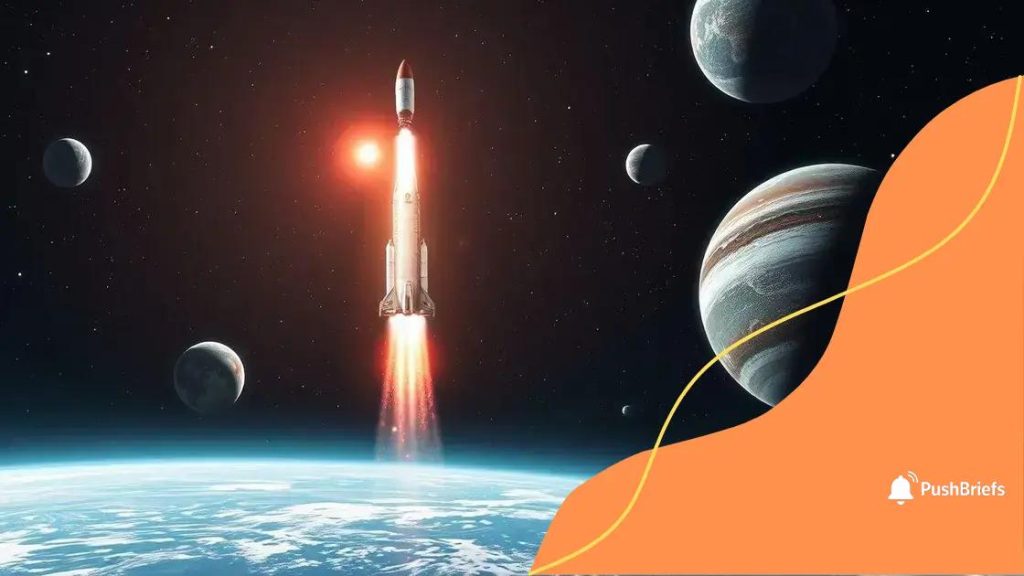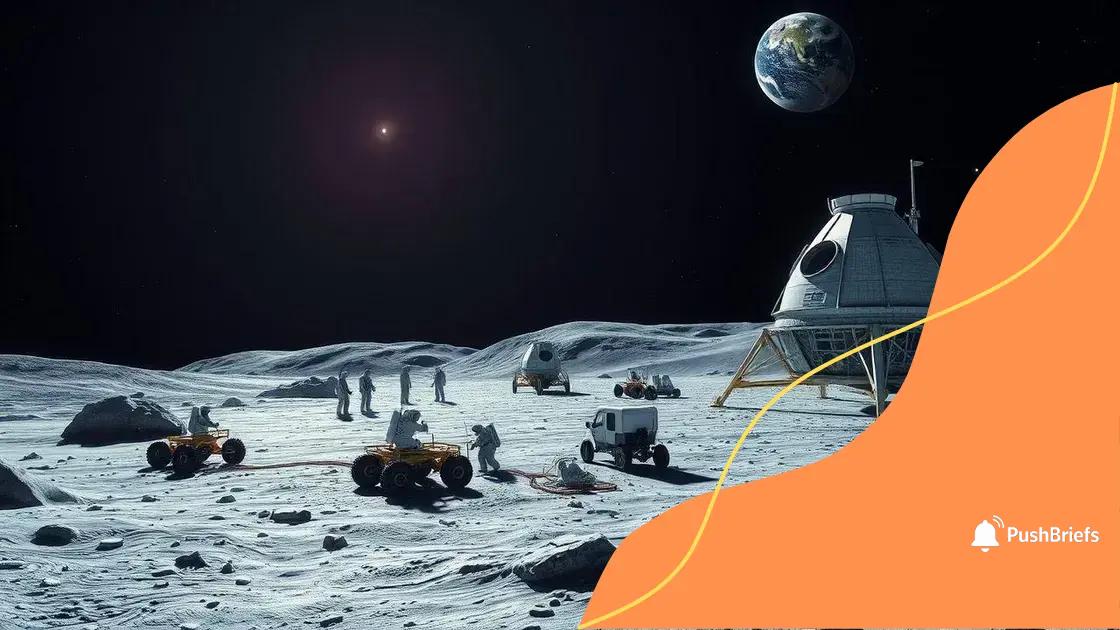Space exploration missions planned for the next decade

International collaboration on space missions enhances scientific progress by allowing countries to share resources and technology, leading to groundbreaking discoveries and inspiring future generations in STEM fields.
Space exploration missions planned for the coming years are shaping the future of our understanding of the cosmos. Have you ever wondered what discoveries lie ahead? Join us as we delve into these exciting projects and their potential impact on humanity.
Upcoming missions to Mars
Many upcoming missions to Mars aim to explore the planet’s surface and gather vital data. These missions represent significant steps in understanding Mars and its potential for human exploration. Let’s delve into what these missions entail and what we can expect.
NASA’s Artemis Program
The Artemis program is not only focused on the Moon but also on preparing for future Mars missions. It includes testing new technologies that will be crucial for survival on Mars. This program will pave the way for astronauts to eventually journey to the Red Planet.
Elon Musk’s SpaceX Plans
SpaceX is developing the Starship rocket, which is designed for human transport to Mars. This rocket will help achieve Musk’s vision of a city on Mars. The planned test flights aim to ensure safety and efficacy for future colonization.
- Testing life-support systems
- Establishing communication networks
- Conducting surface exploration
- Gathering soil samples
As we prepare for these upcoming missions, it’s important to note the international collaboration involved. Space agencies around the world are contributing to launches, technology, and research.
In addition to NASA and SpaceX, other countries like China and the UAE have announced their own missions to Mars. China aims to study Martian soil and atmosphere, while the UAE’s Hope Probe focuses on gathering data on Mars’ weather. These efforts enhance our collective knowledge about Mars.
Potential for Human Life
The ultimate goal of these goals is to understand if humans can live on Mars. The conditions there are harsh, but with advanced technology and preparation, many believe a sustainable human presence is achievable. Ongoing research will continue to reveal what is possible.
In summary, the upcoming missions to Mars not only enhance our understanding of the planet but also prepare humanity for future exploration. These missions demonstrate our commitment to venturing beyond Earth, seeking new opportunities in our solar system.
Exploring the outer planets
Exploring the outer planets of our solar system offers insights into the cosmos that are both exciting and challenging. Each planet, from Jupiter to Neptune, has unique features that provoke curiosity and scientific inquiry. Let’s dive into the significance and plans associated with these distant worlds.
The Gas Giants
The outer planets, often referred to as gas giants, include Jupiter and Saturn. These massive planets have thick atmospheres and complex weather patterns. Observing them helps scientists understand planetary formation and the evolution of our solar system.
- Jupiter’s Great Red Spot: A massive storm larger than Earth.
- Saturn’s Rings: Made of ice and rock particles, they are stunning to observe.
- Magnetic Fields: Both planets have powerful magnetic fields that influence their surroundings.
Exploration missions like NASA’s Juno have provided critical data about Jupiter’s atmosphere and magnetic field. This mission continues to enhance our understanding of the largest planet in our solar system.
Uranus and Neptune
Further out, we find Uranus and Neptune, the ice giants. These planets are less understood due to their distance but are fascinating because of their unique compositions.
Uranus has an unusual tilt, making it appear to roll along its orbit. Meanwhile, Neptune is known for its vibrant blue color and strong winds. Future missions aim to study their atmospheres and potential moons to gather more data.
Scientists believe there may be hidden oceans beneath the clouds of these ice giants. Studying these features could offer clues about the formation of planetary systems.
Technology for Exploration
The technologies used to study the outer planets are constantly evolving. Spacecraft equipped with advanced instruments can gather a plethora of data over vast distances. Missions like Voyager 1 and 2 sent back stunning images and critical information about these distant worlds.
The upcoming missions are set to build on this groundwork. By sending both orbiters and landers, scientists hope to gather atmospheric samples and surface data that can answer long-standing questions.
Exploring the outer planets not only satisfies our curiosity about the universe but also helps us understand the potential for life beyond Earth. As we continue to push the boundaries of our exploration, who knows what secrets these giant planets might reveal?
The importance of the Moon base

The establishment of a Moon base holds tremendous significance for the future of space exploration. It serves not only as a stepping stone for missions to Mars but also as a hub for scientific research and international collaboration. Understanding its importance can inspire advancements in technology and exploration.
Gateway to Deeper Space
A base on the Moon allows us to test systems and technologies that are crucial for human survival on other planets. The Moon’s proximity to Earth makes it an ideal location for these tests. Astronauts can conduct experiments in a lower gravity environment while being only a few days away from home.
- Testing life support systems
- Practicing lander operations
- Conducting research on lunar resources
These activities can provide insights into how we might live and work on Mars and beyond.
Scientific Research
The Moon also offers unique opportunities for scientific research. Its surface remains relatively unchanged compared to Earth, making it an ideal site for studying the history of our solar system. Instruments set up on the Moon can gather data on cosmic radiation, lunar geology, and even conduct astronomy without atmospheric interference.
With fewer resources used, exploring the Moon can yield significant scientific returns. Lunar missions can help answer fundamental questions about the universe’s origins and the formation of planetary bodies.
International Collaboration
Establishing a base on the Moon is an opportunity for countries around the world to collaborate. Joint missions can foster goodwill and strengthen partnerships between space agencies. Organizations like NASA and ESA have already begun discussions on sharing technologies and research.
Collaboration can lead to shared successes and diversify the approach to tackling challenges posed by extraterrestrial exploration.
In summary, the importance of the Moon base goes beyond just exploration. It represents a new era of international cooperation, scientific discovery, and preparation for our future in the cosmos. As we continue to develop plans for lunar missions, the potential for what we can achieve is limitless.
Private companies in space exploration
Private companies are playing an increasingly vital role in space exploration. Their involvement brings innovation, competition, and new opportunities to the industry. Let’s explore how these companies are shaping the future of space travel.
Leading Players
Companies like SpaceX, Blue Origin, and Virgin Galactic are at the forefront of the commercial space sector. Each of these companies has unique goals and technologies.
- SpaceX: Known for its reusable rockets, SpaceX aims to make space travel more affordable and accessible.
- Blue Origin: Founded by Jeff Bezos, this company focuses on suborbital flight and building infrastructure for future space exploration.
- Virgin Galactic: This company is working on commercial space tourism, offering flights to the edge of space.
These companies not only focus on exploration but also aim to make space travel for civilians a reality.
Technological Innovations
Private companies are pushing the boundaries of technology in space. They are developing new rocket engines and spacecraft designs, aiming for efficiency and safety. Innovations in propulsion systems and materials are essential to reduce costs and enhance performance.
The competitive nature of the private sector encourages rapid advancements, leading to breakthroughs that benefit both space exploration and other industries.
Public and Private Partnerships
Collaboration between government space agencies and private companies is becoming more common. Programs like NASA’s Commercial Crew Program demonstrate the effectiveness of public-private partnerships.
By working together, they can share resources, knowledge, and expertise. This collaboration allows for the pooling of funding and technical support, leading to faster progress in space exploration.
As private companies continue to grow, they encourage a thriving industry that attracts investment and talent. Their contributions mark a shift in how we approach space, emphasizing that exploration is not solely a governmental task. The future of space exploration looks promising with the collaboration of both public agencies and private enterprises.
International collaboration on space missions
International collaboration on space missions has become increasingly essential for advancing our understanding of the universe. By combining resources, knowledge, and expertise, countries can achieve more ambitious goals in space exploration. This cooperation not only enhances scientific research but also builds strong diplomatic relationships.
Shared Goals
Countries participating in space missions often share common objectives. This includes exploring asteroids, studying Mars, and conducting research on the Moon. By working together, they can pool their technological expertise and financial resources.
- Example: The Mars Sample Return mission aims to bring samples from Mars back to Earth with the help of international partners.
- Example: The Artemis program involves collaboration between NASA, ESA, and other countries to return humans to the Moon.
- Example: The International Space Station (ISS) represents a pinnacle of cooperation among multiple nations.
This synergy can expedite development and improve mission outcomes.
Technology and Innovation
The exchange of information between nations leads to technological innovations. For instance, collaboration on satellite technology has improved communication systems and weather forecasting. When countries work together, they can share research findings, reducing duplication of effort and accelerating progress.
International analyses of data collected from space have revolutionized our understanding of Earth and beyond. Together, nations can tackle challenges that no single country can handle alone.
Cultural Exchange and Inspiration
Collaborating on space missions fosters cultural exchange and inspires future generations. Young people in different countries can see the possibilities of working in science and technology fields. Joint projects often involve educational initiatives that engage students, promoting interest in STEM.
This creates a sense of unity among nations, showing that space exploration transcends borders and ultimately benefits humanity. Events like the launch of collaborative missions draw global interest, showcasing the spirit of cooperation.
Through international collaboration on space missions, countries can achieve great things while inspiring future generations to pursue dreams of exploration and discovery. The potential outcomes extend beyond space, positively impacting Earth and its inhabitants.
FAQ – Frequently Asked Questions about International Collaboration on Space Missions
Why is international collaboration important in space exploration?
International collaboration enables countries to share resources and knowledge, leading to more significant advancements and discoveries in space.
How do countries share technology during collaborative missions?
Countries exchange data and technology, reducing costs and duplication of efforts while enhancing mission efficiency.
What are some examples of successful international partnerships in space?
The International Space Station (ISS) and the Mars Sample Return mission are two notable examples where multiple countries work together toward shared goals.
How does collaboration inspire future generations in STEM fields?
Joint space missions capture the imagination of young people, encouraging them to pursue careers in science, technology, engineering, and math.
